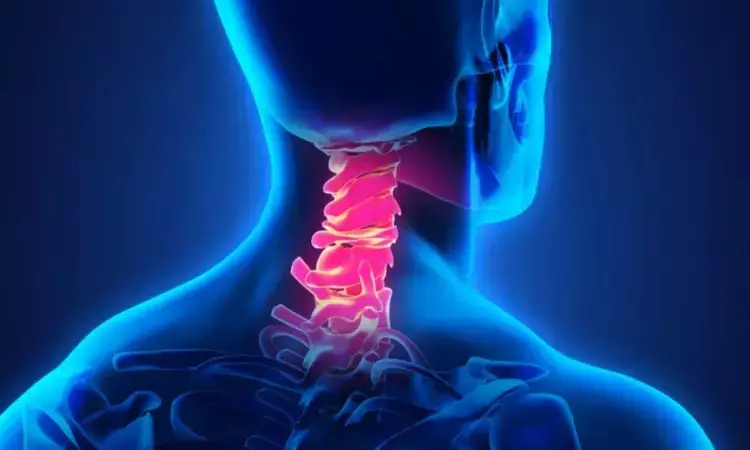- Home
- Medical news & Guidelines
- Anesthesiology
- Cardiology and CTVS
- Critical Care
- Dentistry
- Dermatology
- Diabetes and Endocrinology
- ENT
- Gastroenterology
- Medicine
- Nephrology
- Neurology
- Obstretics-Gynaecology
- Oncology
- Ophthalmology
- Orthopaedics
- Pediatrics-Neonatology
- Psychiatry
- Pulmonology
- Radiology
- Surgery
- Urology
- Laboratory Medicine
- Diet
- Nursing
- Paramedical
- Physiotherapy
- Health news
- Fact Check
- Bone Health Fact Check
- Brain Health Fact Check
- Cancer Related Fact Check
- Child Care Fact Check
- Dental and oral health fact check
- Diabetes and metabolic health fact check
- Diet and Nutrition Fact Check
- Eye and ENT Care Fact Check
- Fitness fact check
- Gut health fact check
- Heart health fact check
- Kidney health fact check
- Medical education fact check
- Men's health fact check
- Respiratory fact check
- Skin and hair care fact check
- Vaccine and Immunization fact check
- Women's health fact check
- AYUSH
- State News
- Andaman and Nicobar Islands
- Andhra Pradesh
- Arunachal Pradesh
- Assam
- Bihar
- Chandigarh
- Chattisgarh
- Dadra and Nagar Haveli
- Daman and Diu
- Delhi
- Goa
- Gujarat
- Haryana
- Himachal Pradesh
- Jammu & Kashmir
- Jharkhand
- Karnataka
- Kerala
- Ladakh
- Lakshadweep
- Madhya Pradesh
- Maharashtra
- Manipur
- Meghalaya
- Mizoram
- Nagaland
- Odisha
- Puducherry
- Punjab
- Rajasthan
- Sikkim
- Tamil Nadu
- Telangana
- Tripura
- Uttar Pradesh
- Uttrakhand
- West Bengal
- Medical Education
- Industry
Novel High-Precision Technique for Subaxial Cervical Fixation Shows Promise, finds research

A new study published in the Journal of Surgery showed that a novel technique using lateral mass screws provides a precise, safe, and low-complication method for subaxial cervical fixation, especially in cases needing posterior stabilization. However further research with larger patient groups and long-term follow-up is suggested to confirm its effectiveness.
Trauma, degenerative diseases, and tumors are among the frequent causes of pathology in the subaxial cervical spine. A biomechanically sound method of attaining stability is posterior cervical fixation using lateral mass screws (LMS). The main differences between established methods, such as those outlined by Anderson, An, Roy-Camille, and Magerl, are in angulation, trajectory, and entrance point. These methods do, however, have the potential to cause neurovascular harm, like damage to the vertebral arteries and spinal roots. Because of the lateral masses' intricate anatomy and close proximity to vital organs, including the nerve roots and spinal arteries, careful screw placement is required.
Complications include lateral mass fractures, screw malposition, and neurovascular injuries, which are still a problem even with improvements in surgical methods. Thus, this study was to present a new method of subaxial cervical fixation using lateral mass screws, with a focus on clinical results, safety, and anatomical accuracy.
30 patients receiving cervical spine surgery using the suggested approach were retrospectively analyzed. A consistent categorization system was used to assess the precision of screw insertion (G0-G4). Facet fractures and lateral migration were among the complications noted. When appropriate, comparative evaluations and descriptive statistics were incorporated into the statistical analysis.
Of the 204 screws examined, 32.35% had little cortical perforation (G1) and 59.31% had no deviation (G0). Facet fractures (1.96%) and lateral migration (3.43%) were among the complications. 91.66% was the total accuracy rate (G0 + G1). The suggested strategy showed a good safety profile and similar attachment strength to conventional methods.
Overall, a precise and secure alternative for subaxial cervical fixation is provided by the innovative LMS method. It is a prospective substitute for well-established techniques due to its high accuracy rate and low complication rate. In our first series, the precision and tolerable complication rates (5.39%) of our modified lateral mass screw approach demonstrated that it provides a dependable, navigation-independent alternative for subaxial cervical fixation.
Reference:
Subaxial cervical fixation with lateral mass screws: A technique variant. (2025). Journal of Surgery (Lisle, IL), 10(4). https://doi.org/10.29011/2575-9760.011287
Neuroscience Masters graduate
Jacinthlyn Sylvia, a Neuroscience Master's graduate from Chennai has worked extensively in deciphering the neurobiology of cognition and motor control in aging. She also has spread-out exposure to Neurosurgery from her Bachelor’s. She is currently involved in active Neuro-Oncology research. She is an upcoming neuroscientist with a fiery passion for writing. Her news cover at Medical Dialogues feature recent discoveries and updates from the healthcare and biomedical research fields. She can be reached at editorial@medicaldialogues.in
Dr Kamal Kant Kohli-MBBS, DTCD- a chest specialist with more than 30 years of practice and a flair for writing clinical articles, Dr Kamal Kant Kohli joined Medical Dialogues as a Chief Editor of Medical News. Besides writing articles, as an editor, he proofreads and verifies all the medical content published on Medical Dialogues including those coming from journals, studies,medical conferences,guidelines etc. Email: drkohli@medicaldialogues.in. Contact no. 011-43720751


